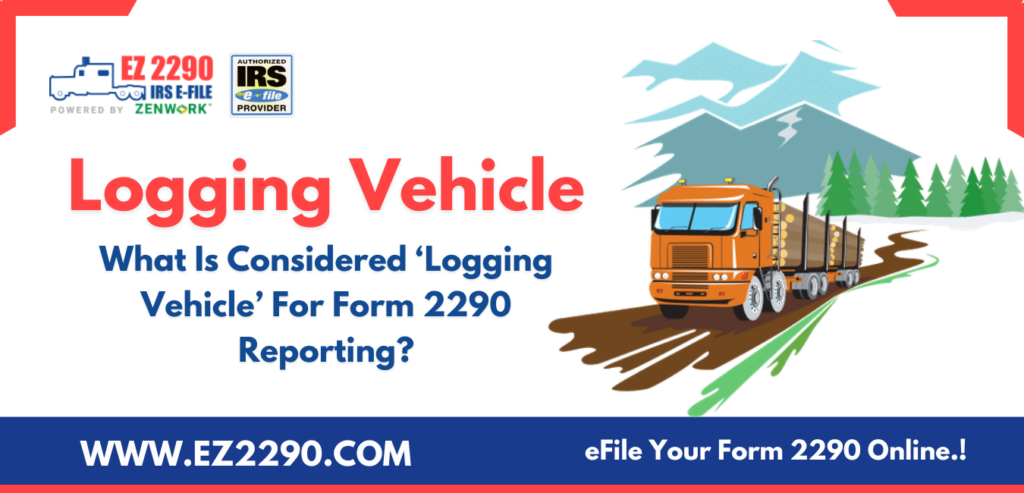
What is a logging vehicle, and how does it impact your HVUT taxes? Learn all about logging vehicles and the tax implications of logging vehicles in this quick guide.
According to the IRS, a heavy vehicle doesn’t necessarily need to be a truck.
It could be any mobile vehicle that weighs 55,000 pounds or more and utilizes the federal highways for transportation.
However, only a few vehicles are qualified for HVUT.
The weight of the vehicle and its utilization of federal highways is one of the qualifying factors for HVUT tax.
These factors differentiate “heavy” vehicles from “regular” vehicles.
Heavier vehicles tend to utilize the highways for transportation purposes and wear off the highways gradually.
As a result, the damaged roads need more funds for repair and maintenance.
The heavy vehicle owners are required to report the miles utilized on federal highways in a calendar year and pay the taxes accordingly.
A heavy vehicle must drive at least 5000 miles on the highways (non-agricultural trucks) and 7500 miles (agricultural trucks and vehicles) to be qualified for HVUT taxes.
Otherwise, the vehicles are suspended from HVUT.
So, if you own a truck, and it happens to weigh about 55,000 pounds or more, and the vehicle was used for 5000 miles or more, then the vehicle is subject to HVUT taxes, depending on the month in which the vehicle was first used.
Now that you have some context on 2290 reporting and its pre-qualifications, let’s try to understand what logging is and its implications on heavy highway vehicle usage tax (HVUT).
What Is Logging?
Logging is a terminology used in IRS HVUT filings to define vehicles that are exclusively used for transporting lumber and other forestry goods to and from harvest locations.
If your vehicle is exclusively used for transporting forestry goods, then the IRS will categorize your vehicle as a “logging vehicle”.
You will be taxed at different rates compared to regular heavy vehicles if your vehicles are reported as “logging vehicles” on 2290 forms.
Here’s how you can differentiate a logging vehicle from a regular one.
| Logging Vehicle | Regular Vehicle |
| A logging vehicle exclusively transports goods or products harvested from a forest. | A regular vehicle is used for transporting a variety of goods and commodities. |
| It is exclusively used for transporting forestry products to and from different points within the forest. | A regular vehicle can be used for transporting a variety of products from and to any location within the U.S. (and sometimes even bordering states). |
| A logging vehicle is usually registered as a highway vehicle for the purpose of transporting harvested forest products under the state laws in which the work is conducted. | A regular vehicle is registered with the state DOT for commercial transportation purposes. The vehicle owner may need to buy special permits when transporting goods to international jurisdictions. |
Vehicle Logging: Classification & Paperwork
A logging vehicle can be a lorry, a goods truck, a flatbed truck, or even a tractor with integrated loading units.
Contrary to popular belief, logging vehicles do not need to have any special licenses or number plates to identify the vehicle as a “logging vehicle”.
From the outside, you may not be able to tell the difference between a regular truck and a logging truck.
However, if prompted, the vehicle owner or the operator is required to produce the relevant paperwork and permits to the authorities to prove that the logging vehicle is specifically used for transporting forestry goods and products.
Reporting Logging Vehicles On Form 2290
- When reporting with Form 2290, it is important to differentiate if your filings are for logging or non-logging vehicles.
- The “Tax Computation” section of Form 2290 requires the filer or the preparer to specify whether the vehicle is a “logging vehicle”.
- If you’re eFiling, you will be prompted to confirm whether you’re filing for logging vehicles. If you are reporting and filing Form 2290 HVUT for logging vehicles, then select “yes” in the dropdown menu.
- A logging vehicle count must be separated from the regular highway vehicles for tax reporting purposes. This is especially crucial if you’re reporting for multiple vehicles at once.
- It is essential to note that logging vehicles are taxed comparatively less. A regular vehicle that weighs 55,000 pounds is taxed at $100, but a logging vehicle that weighs the same is taxed at $75.
File 2290 Form For Logging Vehicles With EZ2290
If you’re looking for a simplified eFiling solution to report your logging vehicles and file a 2290 form, then EZ2290 is the ideal choice for you.
EZ2290 is an IRS-authorized eFile provider, trusted by 10,000+ truckers.
We enable:
- Quick and easy bulk data import
- Real-time TIN matching
- Dynamic form completion
- Automatic HVUT tax calculations
- Secure & encrypted eFile transmissions
- Free 2290 VIN Corrections
- Free Re-files for rejected returns
- Online options to pay your HVUT with convenience
- Priority 2290 tax support
And much more.
Calculate Logging Tax For Free | eFile 2290 For Logging Vehicles
Other Useful Reads From Ez2290 Blog
- Understanding Farm Vehicles On Form 2290
- How Do I Fill Out A 2290 Form? HVUT 2290 Form Box Wise Instructions
- Reported Incorrect VIN On Form 2290? Here’s How To Correct VIN Number Online
- Only A Few Days Left To eFile Your 2290 Forms. Are You Ready?
- How Trucking Companies Are Saving Time With EZ2290’s Bulk Upload






